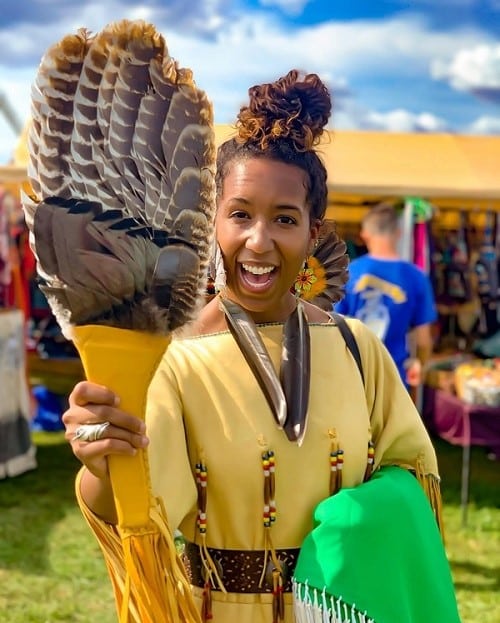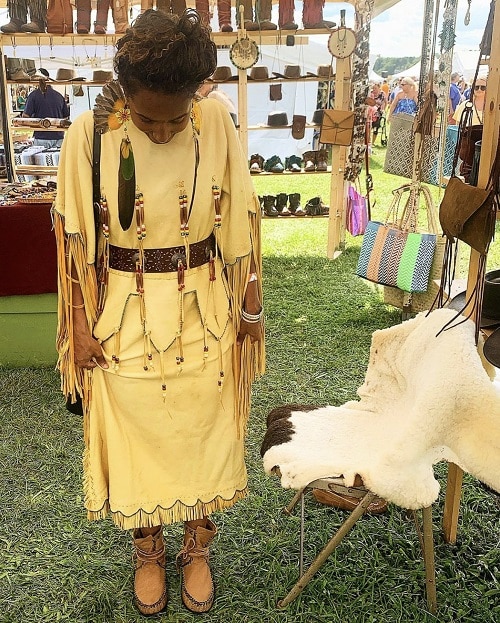On Native American Heritage Day, we are honored to share this interview with designer Jasmine K. Burton.
Jasmine Burton, or Bright Smiling Sage of the Nanticoke Nation, hails from Atlanta, GA, the ancestral and territorial lands of the Muscogee and Cherokee tribes. She is a 1Y MBA Candidate at Emory University’s Goizueta Business School. Ultimately she seeks to utilize design thinking, evidence-based research, and business acumen to build a more inclusive world by founding and leading various impact ventures including Wish for WASH, Hybrid Hype, and Period Futures.
Pictured: Jasmine in a dress made by an Indigenous Artisan from the Nanticoke Nation.
Read Jasmine’s article in the “Decolonizing Industrial Design” issue of IDSA’s INNOVATION magazine
Tell us about your heritage. How has this shaped you into the designer you are today?
As a mixed-race person and a hybrid professional, I exist as the intersection of many identities both personally and professionally. I have a persona that is a harmony between disruptive global health practitioner, a member and dancer of the Nanticoke Native American tribe, and a young Black woman entrepreneur. More than labels, I am an advocate for storytelling who seeks to amplify and add to the long line of Black and indigenous stories that focus on resilience and successes in a larger narrative.
My design practice is deeply rooted in empathy and iteration as I seek to use my product design skillsets and design thinking mindsets as generative, inclusive, and asset-based tools to help drive sustainable development, particularly related to work rooted in health equity, gender parity, racial justice, and social inclusion.
I firmly believe that design—especially human-centered design—has the power to change the world if used and proliferated intentionally. Across my ventures and vocations, we seek to design for dignity and ownership by designing ‘with’ not ‘for’ in the water, sanitation, and hygiene (WASH), menstruation, and global health sectors. I believe my indigenous and mixed raced identities provide me with a nuanced perspective of how to build and lead at the intersection of the creative and impact economies.
Specifically, it has been helpful for me in my growth story to lean into the idea that ‘we all have power’ within us, rooted in the histories of our identities and communities, even if we don’t always see that in ourselves. This can help us realize that historically, the communities that we come from got us to where we are. Women throughout history—particularly Black and Native Women—have showed time and time again their immense strength and resilience in the face of adversity, So, when I feel the imposter syndrome or self-doubt creep in, I lean on their power—the power of women who came before me—because their power and strength is a part of me. And I believe that if you can recognize your own power, you can recognize your own privilege and better understand how you can be an effective, empowering, and sustainable woman in design, business, and life at large. I believe we all need to be lifted; but in order to be lifted, you also have to lift others. We are all connected.


What do you wish more people knew about Indigenous cultures and design?
I wish more people would recognize that indigenous people are actively here today—living, building, and creating in ways that honor both their people and the planet. As we continue moving through this time of rapid change, I hope society will move away from fetishizing and appropriating indigenous ways, and towards empowering and enabling native people to teach, lead, and grow in their practices, to ultimately help society at large to create more sustainable and inclusive products, businesses, and ways of life.
For industrial designers looking to get involved and learn more about Indigenous design and communities, how do you recommend they start?
In this season of thanks, I would recommend you:
- Learn about the indigenous communities near you, about whose land you occupy, and about indigenous realities both past and present
- Unlearn pervasive narratives that exclude native voices and representation
- Give – Thoughtful and researched land recognitions; money towards indigenous owned businesses; and time to respectfully learn about, support, and advocate for indigenous designers and artisans both locally and globally
